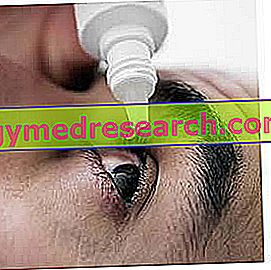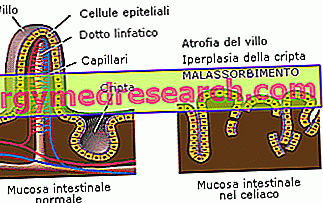Generality
Tetanus is an acute and potentially lethal infectious disease, which in our country - as in all industrialized ones - is now fortunately rare, thanks to the vaccine.

Clostridium tetani is an obligate anaerobic bacterium, producer of a powerful neurotoxin that can be found almost everywhere: from the digestive tract of herbivorous animals (where, however, it does not cause any damage or infection) to the faeces of these animals, from most of the soils to the surface of the plants (eg: on thorns of brambles), from rusty metal objects to dust that covers the rooms, etc.
What is tetanus?
Tetanus is a severe and acute infectious disease of bacterial origin, which affects the nervous system and is responsible for characteristic muscle spasms, first at the level of the jaw and, subsequently, throughout the body.
Epidemiology
If in the most developed countries (United States, England, Germany, France, Italy etc.), where the vaccine is widespread, tetanus is now a rare infection, in the poorest geographical areas of the world, the same infection still remains a serious one problem; this is due to the fact that in these countries there are still no advanced vaccination programs.
To get an idea of how widespread tetanus is in the world and in an industrialized country like the United States, here are some interesting numerical data:
- In 2015, there were 209, 000 registered tetanus cases worldwide; of these, approximately 59, 000 (more than 20%) were fatal;
- From 2000 to 2008, in the United States, there was an annual average of only 31 cases of tetanus.
Among the unvaccinated against tetanus, the latter can have unfortunate consequences, in a fair number of circumstances, even deadly, especially if the person affected by the infection is a small child or an elderly person.
Causes
"Infectious disease of bacterial origin" means an affection that appears due to a bacterium.
In the specific case of tetanus, the bacterium responsible for the latter is the so-called Clostridium tetani .
The Clostridium tetani
Equipped with a stick form, Clostridium tetani is a Gram-positive bacterium, existing in nature both in vegetative and in spore form.
In vegetative form, it behaves like an obligate anaerobic micro-organism, where "obliged anaerobic" means that:
- It grows, replicates and is able to germinate only in the absence of molecular oxygen;
- Suffers, to the point of not being able to survive, in the presence of molecular oxygen.
Furthermore and only in vegetative form, it is also capable of producing a toxin - called tetanospasmina - which, having a particular affinity for some membrane receptors of human neurons, succeeds in penetrating into the central nervous system and strongly compromising its functions (it is the cause of the characteristic spasms of tetanus).

Clostridium tetani is a ubiquitous bacterium; in the guise of spores, in fact, it populates many soils, dust, the surface of rusty metal objects, the intestines of animals such as horses, cows, sheep, dogs, cats and chickens (without having any infectious consequences), the faeces of the aforementioned animals, the agricultural fields fertilized with manure derived from the faeces of the aforementioned animals, heroin, etc.
WHAT MOTIVATES THE PASSAGE FROM THE VEGETATIVE FORM TO THAT OF SPORA AND VICEVERSA
To motivate Clostridium tetani's assumption of the vegetative form is the absence of oxygen, a condition which - as previously stated - is the basis of the growth and replication capacity of the bacterium in question.
On the other hand, the passage by Clostridium tetani of the spore form is justified by the presence of molecular oxygen and the need to live in adverse environmental conditions for long periods of time; therefore, the sporogenesis (ie the transformation into spores) is, for Clostridium tetani, a quiescent phase, assumed until the ideal conditions arise to return to the vegetative form (the latter process, known as germination ).
The Clostridium tetani spore is a form of life "armored", capable of resisting many of the strongest antiseptics.
Brief review of some fundamental terms to understand the "life cycle" of Clostridium tetani
- "Vegetative form of Clostridium tetani ": means that Clostridium tetani is in that vital state that allows it to grow, replicate and produce the tetanospasmin toxin.
- " Clostridium tetani is an obligate anaerobic bacterium": it means that, in order to grow and replicate, Clostridium tetani needs to be in the absence of molecular oxygen; the latter, in fact, causes his death.
- " Clostridium tetani is a sporogenic bacterium": it means that Clostridium tetani is able to turn into spore, when the environmental conditions are adverse to its vegetative life. The spore of Clostridium tetani resists oxygen, the most extreme environmental conditions, heat and many powerful antiseptics.
- " Clostridium tetani produces a neurotoxin": it means that Clostriudium tetani produces a toxin with an affinity for the human nervous system, in particular for the brain and the spinal cord.
- " Clostridium tetani germination ": it occurs when Clostridium tetani passes from the spore form to the vegetative form.
TETANOSPASMINA: SOME FUNDAMENTAL INFORMATION
Tetanospasmin reaches the central nervous system, thanks to its affinity for receptors on peripheral nerve endings; this affinity, in fact, allows it to penetrate inside the neurons and travel along the peripheral nerves, until it reaches the cells of the brain and the spinal cord .
Reached the central nervous system, therefore, tetanospasmin operates in such a way as to block the release of two neurotransmitters with inhibitory function, the glycine and the so-called GABA, which are fundamental for the correct fine control of the striated muscle movement.
This means that, when tetanospasmin is in the brain and spinal cord, the striated muscles are out of control (the muscle spasms mentioned were the proof), due to the absence of the nervous mechanism that finely governs them.
As Clostridium tetani causes tetanus: the infection
Premise: Clostridium tetani can cause tetanus only in those who are not vaccinated or have not undergone the prescribed recalls.
To classically cause tetanus in human beings are cutaneous wounds resulting from the penetration of foreign bodies contaminated by Clostridium tetani spores ; in fact, these particular wounds of the skin, in addition to guaranteeing the transfer of the spores inside them, tend to close, effectively preventing the entry of air, so as to guarantee the aforementioned spores an anaerobic (ie devoid of oxygen) environment for the germination process. As mentioned above, the transition to the vegetative form is essential to allow Clostridium tetani to grow, replicate and generate the so-called tetanospasmin, ie the neurotoxin which, spreading in the central nervous system, produces the symptoms of tetanus.
What characteristics must a wound have in order for the risk of tetanus to exist?
To promote the onset of tetanus, a skin wound must not be exposed to the air, but must be deep and closed, in such a way as to guarantee Clostridium tetani a condition of anaerobiosis (absence of oxygen).
To have the aforementioned characteristics are, as a rule, tear or pointy wounds, such as those resulting from the penetration of a foreign body (such as a spine), on which spores of Clostridium tetani reside.
At the conclusion of this brief engraved on the characteristics of the wounds that favor the development of tetanus, a curiosity is reported: if they do not immediately find the ideal conditions for germination, the spores of Clostridium tetani can remain at the penetration site, even for long periods, in waiting to reactivate as soon as the local conditions of anaerobiosis arise.
OTHER WAYS OF CONTAGIOUS IN PERSONS NOT VACCINATED
Other more or less common ways, with which Clostridium tetani can infect an unvaccinated human being and trigger tetanus, are:
- Skin wounds produced by contaminated objects, which lead to extensive tissue devitalization . In these situations, tissue devitalization is fundamental for the onset of infection, as it causes the interruption of the supply of blood, and therefore of oxygen, to the tissues contaminated by Clostridium tetani spores;
- Abrasions and burns;
- Body piercing and tattooing, performed with instruments that are not properly sanitized and sterilized;
- Animal bites;
- Contaminated drug injections (eg, heroin);
- Umbilical cord cutting with inadequately sterilized instruments. In these situations, the possibility of developing tetanus concerns newborns born to unvaccinated women; the infectious disease that derives from it is known as neonatal tetanus, a condition which has now completely disappeared in the so-called Western countries but is still widespread in the poorest countries.
Incubation period
The incubation period of Clostridium tetani (that is the time that must pass from the Clostridium tetani germination to the appearance of the symptomatology dependent on it) is on average 10 days, even if - it is necessary to specify it - it can last from a minimum of 3 to a maximum for 21 days.
Two interesting facts about the incubation period of Clostridium tetani
- The more the place of access of Clostridium tetani in the human body is far from the components of the central nervous system (encephalon and spinal cord), the longer is the incubation period.
- An incubation period of reduced duration coincides with a more serious symptomatology; translated, the more the incubation is short, the lower the hopes of recovery.
Risk factors
All unvaccinated people and those who have forgotten to undergo the prescribed vaccination recalls are at risk of tetanus (NB: failure to carry out the vaccination booster leads to loss of immunity against Clostridium tetani ).
WHO IS MORE AT RISK AMONG PEOPLE NOT VACCINATED / NOT IMMUNE
A non-vaccinated / non-immune person against tetanus is at risk of the latter when:
- It suffers wounds or skin lesions from the penetration of foreign bodies such as nails, plugs or contaminated splinters;
- He is the victim of the bite of an animal contaminated by spores;
- He is a victim of burns;
- He uses injectable drugs (the use of heroin is the most common case);
- He is a victim of foot ulcers;
- He undergoes piercing or tattooing practices that do not respect the most common hygiene and sterilization rules;
- He is a victim of dental infections.
Is tetanus a communicable disease in person?
Tetanus is not a contagious disease ; in other words, those suffering from tetanus cannot transmit the infection they are victim of to other people, a phenomenon that instead occurs for diseases such as pertussis, poliomyelitis, diphtheria, etc.
Symptoms and complications
In attacking the central nervous system of human beings, tetanospasmin impairs the control of striated muscles in the body, causing spasms (muscle) and stiffness (muscle).
In general, the first muscles to suffer from spasms and stiffness, due to the tetanus toxin, are those of the jaw and the face in general; the following are those of the chest, abdomen, neck and back.
The classic consequences of these spasms and this muscular rigidity consist of symptoms and signs such as:
- Difficulty in opening the mouth;
- Difficulty in chewing and swallowing;
- Pain during chewing and swallowing;
- Sardonic rice;
- Opisthotonus. It is the medical term that indicates a severe and abnormal arching of the back, with the head protruding backwards. Opisthotonus is a consequence of the hyperextension and spasticity of the axial musculature located along the entire vertebral column;
- Neck painful and difficult to move;
- Difficulty breathing;
- Choking sensation;
- Pain during movement of the affected muscles.
Other symptoms of tetanus
In addition to the aforementioned symptoms - which constitute the typical symptom picture - tetanus is also responsible for other disorders, including:
- Temperature;
- Profuse sweating;
- Increased blood pressure;
- Increased heart rate;
- Cardiac arrhythmias;
- Poor control of urination and / or defecation;
- Difficulty in moving hands and / or feet due to spasms and stiffness affecting the muscles present in these anatomical sites;
- Sense of fainting;
- Irritability.
What causes and how long do muscle spasms last?
Muscle spasms caused by tetanus can last from a few seconds to a few minutes .
In general - and for unknown reasons - they are triggered by: loud and / or sudden noises, sudden light changes and unexpected physical shocks.
Complications
Over time, muscle spasms and stiffness deteriorate. This deterioration can lead to numerous complications, including:
- Bone fractures . They take place due to strong muscle spasms;
- The repeated involuntary contraction of the vocal cords ( laryngospasm );
- Pulmonary embolism . This is the medical condition characterized by the presence of an obstacle (NB: in the case of tetanus the obstacle is a blood clot) at the level of one of the pulmonary arteries or one of the branches of the pulmonary arteries;
- Aspiration pneumonia . It is one of the two main causes of death among individuals suffering from tetanus;
- Respiratory failure . It is the other of the two main causes of death among tetanus sufferers. It is generally responsible for asphyxia followed by cardiac arrest .
When should I go to the doctor?
Tetanus represents a medical emergency. Therefore, all those who are victims of skin wounds or risky events (of tetanus, of course) and who are not vaccinated or have not undergone the intended tetanus booster should contact their doctor immediately or go to the nearest hospital, to receive all the necessary therapeutic support.
Diagnosis
The diagnosis of tetanus is based exclusively on a critical and extremely thorough evaluation of the signs and symptoms present (objective examination and anamnesis), and on information relating to the patient's immune history (in other words, whether or not the vaccine was carried out against tetanus).
Currently, in fact, there are no laboratory tests capable of identifying Clostridium tetani infection.
Therapy
The treatment of tetanus is different depending on whether the infection is only suspected or symptomatic.
Tetanus therapy in suspected cases
For suspected tetanus cases (ex: unvaccinated individual who was injured with a rusty nail), the therapy includes:
- The care of what could have allowed the entry of spores into the body and which could lead to germination (eg: cleaning of a skin wound caused by a nail, treatment of an animal bite, etc.);
- The administration, by intravenous injection, of specific immunoglobulins against the tetanus toxin or tetanospasmin ;
- The practice of the tetanus vaccine .
Tetanus therapy in symptomatic cases
For the cases of symptomatic tetanus (in which, therefore, there is the certainty of the infection), the therapy foresees:
- Hospitalization in intensive care ;
- The care of what has allowed the entry of spores into the body and their germination (eg: cleaning of a skin wound caused by a nail, treatment of an animal bite, etc.);
- Intravenous administration of specific immunoglobulins against tetanospasmin;
- The intravenous administration of antibiotics, in order to counteract Clostridium tetani . Generally administered for at least ten days, the most widely used antibiotics in those suffering from tetanus are metronidazole, penicillin, clindamycin, and erythromycin;
- The administration of diazepam, muscle relaxants and magnesium sulfate, orally or intravenously, to calm muscle spasms and muscle stiffness;
- Sedation, to calm the patient.
WHAT DOES INTENSIVE THERAPY PROVIDE?
Intensive care, or intensive care unit, is the hospital ward reserved for the hospitalization of patients in serious health conditions, who need continuous treatment, monitoring and support, in order to maintain their vital functions normally.
During admission to intensive care, tetanus patients may receive treatments such as, for example, mechanical ventilation via tracheotomy, parenteral nutrition and / or PEG (Percutaneous Endoscopic Gastrostomy).
Prevention
The best and most effective weapon to prevent the onset of tetanus is the vaccine against Clostridium tetani, which can be performed from an early age and subjected to periodic recalls every few years.
How to protect yourself from tetanus in Italy
In Italy, as in other countries of the world, the tetanus vaccine is one of the 6 vaccinations that are part of the so-called hexavalent vaccine .
In addition to creating immunity to tetanus, the hexavalent vaccine protects against 5 other serious infectious diseases, which are: diphtheria, pertussis, poliomyelitis, hepatitis B and Haemophilus influenzae type B.
Vaccination references: when are they scheduled?
Immunity against Clostridium tetani, guaranteed by the tetanus vaccine, is not eternal, but must, so to speak, be renewed through new vaccinations, which in specialized jargon are called reminders .
If an individual has been vaccinated against tetanus during the first year of life, tetanus calls are envisaged:
- At the age of 6;
- At the age of 14;
- Every 10 years, after the 14-year recall.
Prognosis
Tetanus can degenerate into complications that cause the death of the infected person.
According to statistics, Clostridium tetani infections are deadly for 10-20% of affected people.
Curiosity
To make the prognostic picture related to tetanus even more serious is the fact that there are no natural immune therapies or mechanisms capable of eliminating tetanospasmin from the central nervous system once it has penetrated into neurons.
Is it possible to heal tetanus? What are the recovery times?
It is possible to recover from tetanus and return to a normal life, provided that the therapy is adequate and timely, and the infection is not the most serious.
For people who completely recover from tetanus, the recovery time is about 1-2 months.



